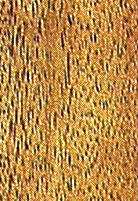
Avor (Pterospermum acerifolium)
Family: Sterculiaceae
Common names: Avor, Bon-morla, Ching-pha, Dieng-dit-la-khoh, Dieng-khoh, Dieng-khong-swet, Dieng-myrhaw, Dieng-sla-um-pai, Dieng-tharo-masi, Gaik, Hathipaila, Hatipaile, Hatipeala, Hattipaila, Kanak-champa, Kanakchampa, Karmkara, Karnikar, Kongla-arong, Kuckokunda mus, Kukla, Laider, Laidorbuphang, Larubanda, Lau-gongrai-baphang, Lokong-krong-arong, Lopok-lok-arong, Machkunda, Magwi-napa, Makcand, Mat-bul-japha, Mayeng, Modubura, Moragos, Morra, Mota-marulia, Muckokunda, Mus, Nakhar-theng, Numblong, Numbong, Rangirata, Rikhabok, Sinna, Sipon-asing, Taguru changne, Taung-petwen, Tepop-paplok, Thadaya-maram, Waisil-thing
Distributed in: Burma, India, Malaysia, Thailand (Oceania and S.E. Asia)
Common uses: Boat building (general), Boxes and crates, Brush backs & handles, Decks, Furniture, Light construction, Matches, Mathematical instruments, Paneling, Plywood, Sporting Goods, Toys, Turnery
Tree size: Trunk diameter is 150-200 cm
Colors: the heart isWhite, Yellowand the sapwoodWhite to yellow, Yellow.The grain isStraight, the textureFine to mediumand the lusterMedium
Natural durability: Perishable, Susceptible to insect attack
Kiln Drying Rate: Naturally dries quickly
Drying Defects: Moderate surface checking, Slight surface checking
Ease of Drying: Rapidly
Tree Identification: Bole/stem form is straight
Comments: General finishing qualities are rated as good
Cutting Resistance: Easy to saw
Gluing: Fairly Easy to Very Easy
Mortising: Poor to Very Poor
Moulding: Fairly Easy to Very Easy
Movement in Service: Fairly Easy to Very Easy
Nailing: Fairly Easy to Very Easy, Very Good to Excellent
Planing: Poor to Very Poor
Resistance to Impregnation: Permeable sapwood
Response to hand tools: Fairly Difficult to Difficult to Work
Turning: Fairly Difficult to Very Difficult
Polishing: Poor to Very Poor; Staining: Fair to Good;
- Numerical data Metric
- Numerical data English
- Strength properties
- References
 |
 |
 |
 |
| Item |
Green |
Dry |
Metric |
| Specific Gravity |
|
|
|
| Density |
|
721 |
kg/m3 |
| Bending Strength |
542 |
849 |
kg/cm2 |
| Crushing Strength |
212 |
362 |
kg/cm2 |
| Hardness |
|
|
kg |
| Impact Strength |
|
101 |
cm |
| Shearing Strength |
|
|
kg/cm2 |
| Stiffness |
83 |
97 |
1000 kg/cm2 |
| Tangential Shrinkage |
|
|
% |
| Radial Shrinkage |
3 |
|
% |
| Weight |
705 |
560 |
kg/m3 |
| Maximum Load |
|
|
cm-kg/cm3 |
| Toughness |
|
|
cm-kg |
| Static Bending |
|
|
kg/cm2 |
|
 |  |  |  | | Item | Green | Dry | English | | Bending Strength | 7711 | 12078 | psi | | Density | | 45 | lbs/ft3 | | Impact Strength | | 40 | inches | | Maximum Crushing Strength | 3027 | 5157 | psi | | Stiffness | 1188 | 1383 | 1000 psi | | Weight | 44 | 35 | lbs/ft3 | | Radial Shrinkage | 3 | | % | | Tangential Shrinkage | 6 | | % | |
Density (dry weight) = 46-52 lbs/cu. ft.
Density (dry weight) = 38-45 lbs/cu. ft.
Toughness-Hammer drop (Impact Strength) = medium
Shrinkage, Tangential = small
Shrinkage, Radial = small
Modulus of Elasticity (stiffness) = very low
Modulus of Elasticity (stiffness) = low
Max. crushing strength = medium
Max. crushing strength = low
Bending strength (MOR) = medium
Bending strength (MOR) = low
Chowdhury, K.A., Ghosh, S.S.,1958,Indian Woods: Their identification, properties and uses Vol. I,Dilleruaceae to Elaeocarpaceae,Manager of Publications, Delhi, IndiaDesch, H.E.,1954,Manual of Malayan Timbers (2 vols,Malayan Forest Records,no.15Gamble, J.S.,1902,A Manual of Indian Timbers,Sampson Low, Marston & Co. LondonHoward, A.L.,1948,A Manual of Timbers of the World.,Macmillan & Co. Ltd. London 3rd ed.McCann, C.,1947,Trees of India: A Popular Handbook,D.B.Taraporevala Sons & Co. BombayPearson, R.S., Brown, H.P.,1932,Commercial Timbers of India,Govt. Printer Calcutta,2 volsTewari, M.C., Jain, J.C.,1980,Utilization of Secondary Species,Journal of the National Building Organization 25(2) pp1-6Whitmore, T.C.,1973,Tree Flora of Malaya A Manual for Foresters Volume 2,Forest Department Ministry of Primary Industries Malaysia
|








